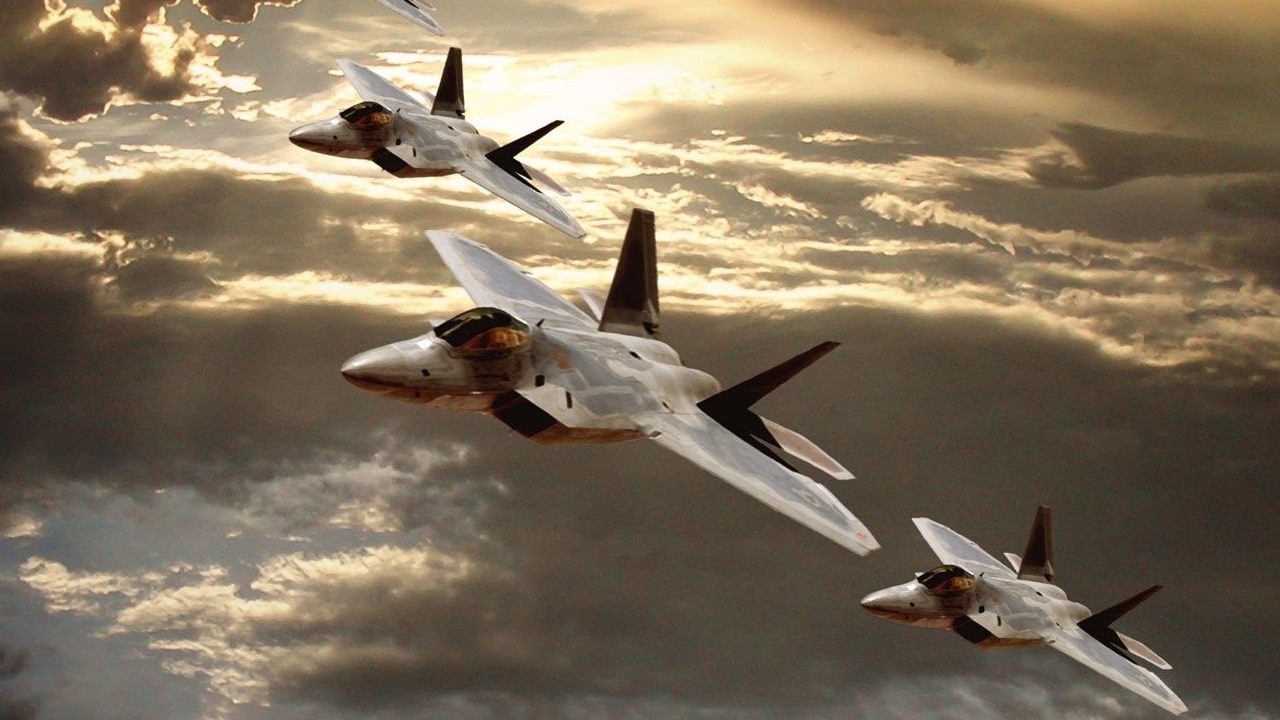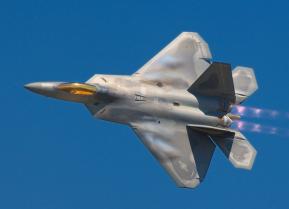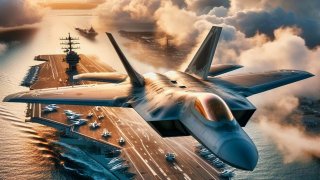The F-22 Sea Raptor Stealth Fighter Was Not A Good Idea
Given that the Cold War had ended, the Navy probably arguably didn't need a stealth aircraft like an F-22 Sea Raptor.
Meet the F-22 Sea Raptor: On November 14, 1910, Eugene Burton Ely became the United States Navy's first aviator when he successfully piloted an aircraft off a temporary platform erected over the bow of the USS Birmingham. It also resulted in the Curtiss Pusher being the first carrier-capable aircraft, which just two months later Ely also successfully landed on the same plane on the deck of the armored cruiser USS Pennsylvania in San Francisco Bay.
In the more than 113 years that have followed, only a small number of aircraft developed to operate from land bases were converted for carrier operations.
In most cases, the U.S. Navy has sought to develop its own aircraft – but over the years there were some plans to modify such aircraft as the P-51 Mustang, which did conduct some limited tests. In addition, consideration was given to developing a carrier-based F-15 Eagle as the F-15N Sea Eagle, while the Model 1600 derivative of the F-16 Fighting Falcon lost out to the F/A-18 Hornet.
So What About the F-22?
In the 1980s, the U.S. Navy announced that it would employ a derivative of the U.S. Air Force's Advance Tactical Fighter (ATF) program to replace its F-15 Tomcats. It had the support of lawmakers in the U.S. Congress, who saw a way to save money by not having to fund two expensive programs, including the Naval Advanced Tactical Fighter (NATF) effort.
In theory, it could have allowed the services to leverage one another's R&D money. But the services aren't known to be all that good about sharing.
However, after the Lockheed YF-22 came out on top in that program, issues became clear. The first fifth-generation fighter aircraft, the F-22 Raptor was developed around its stealth and supercruise abilities.
It simply wasn't designed to be a carrier-based fighter.
As previously reported, to make the F-22 suitable for carrier duty, Lockheed Martin would have had to incorporate several significant changes to the Raptor's design. On the top of the list would have included a tail hook and strengthened fuselage to be able to launch from a catapult and land on a carrier deck.

Those were seemingly small details that would have given designers heartburn.
Moreover, any U.S. Navy variant of the F-22 would have needed to incorporate a variable sweep-wing design similar to that employed by the service's existing F-14 Tomcats. That addition, perhaps more than any of the others, would have been a real challenge for engineers to contend with.
Sweep wings were expensive to maintain, to begin with, but incorporating a sweep-wing design into a stealth aircraft may have been nearly impossible without sacrificing some degree of low observability.
F-22 Sea Raptor: Navy Nixed It
Admiral Richard Dunleavy, the official responsible for outlining the U.S. Navy's requirements for a new fighter, soon led the effort to axe the effort. He simply didn't see any way the F-22 could be incorporated into an affordable platform for naval aviation.
The Navy further realized that a series of upgrades to their existing F-14 Tomcats could meet its air superiority needs in the near future.
Moreover, though the F-22N was studied in the Major Aircraft Review as an NATF concept, it was also canceled in large measure because the projected high gross take-off weight exceed the capacity of current carriers. As an analysis at Global Security noted, early in the ATF/NATF development, a Naval variant of the F-22 could have been developed. Yet, by the late 1990s, to graft a Naval requirement onto an existing F-22 program would be similar to the mistake that the Department made in developing the F-111
Given that the Cold War had ended, the Navy probably arguably didn't need a stealth aircraft like an F-22 Sea Raptor.
After 9/11, the world changed, and the Air Force scaled back the number of F-22s in its fleet. It proved not to be the best aircraft for the Global War on Terror (GWoT), as it was expensive to build and expensive to operate.
The F-35 Was the Better Choice
If anything, the F-22 Raptor highlighted that the U.S. military didn't so much need an air superiority fighter but rather a true multirole aircraft – and that resulted in the development of the Lockheed Martin F-35 Lightning II, which was developed from the Joint Strike Fighter program.
Instead of making an Air Force fighter compatible with a carrier, the Joint Strike Fighter was designed from the ground up with variants that could serve the needs of the Air Force, Navy, and Marines. Three variants were developed, including the Navy's F-35C, the carrier-based model.
The Lightning II carrier variant features several unique design modifications that include larger wings and tail control surfaces to meliorate low-speed control. In addition, the larger wing area can minimize the landing speeds while maximizing range and payload capacity. The naval variant was also designed to launch from the flight deck of a large aircraft carrier through a steam catapult, and it can be integrated with an Electromagnetic Aircraft Launch System (EMALS), while it can be recovered by using a tailhook arrestor.
Most of the features of the F-35 Joint Strike Fighter, including weapon loads, cockpit layout, countermeasures, and radars are retained in the F-35C variant. As with the F-35A model, the F-35C is also powered by a single Pratt & Whitney F135 turbofan engine rated at 125kN of dry thrust. The engine can generate 191.3kN of thrust afterburner.
The F-35C is currently operated by both the United States Navy and the United States Marine Corps.
Author Experience and Expertise
A Senior Editor for 19FortyFive, Peter Suciu is a Michigan-based writer. He has contributed to more than four dozen magazines, newspapers, and websites with over 3,200 published pieces over a twenty-year career in journalism. He regularly writes about military hardware, firearms history, cybersecurity, politics, and international affairs. Peter is also a Contributing Writer for Forbes and Clearance Jobs. You can follow him on Twitter: @PeterSuciu.
Image Credit: All Images are Creative Commons.


